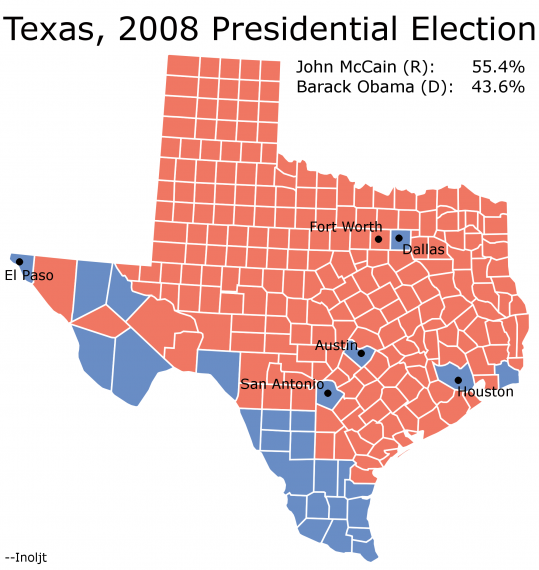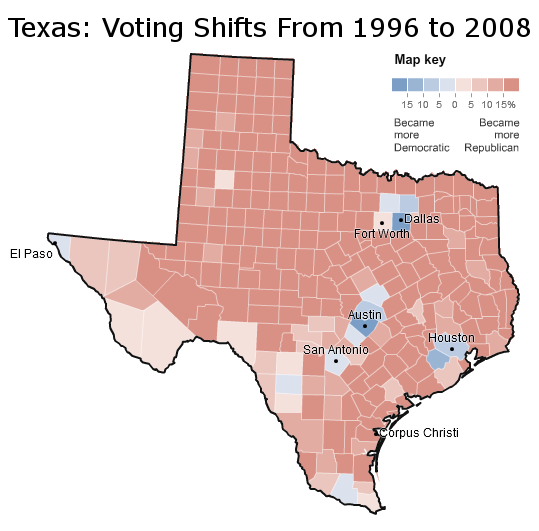• CA-Sen: There’s that quote about people who can’t remember the past… what does it say again? They’re likely to be very, very successful, right? Anyway, PPP looks at the California GOP Senate primary for 2012, and finds the Republican electorate’s preferred candidate to go up against Dianne Feinstein would be… Carly Fiorina?!? She’s at 23, beating out even Meg Whitman, who in fact is tied with Darrell Issa at 16. Tom Campbell’s at 15, Arnold Schwarzenegger is at 6, Steve Poizner’s at 5, Kevin McCarthy’s at 4, and Mary Bono Mack is at 2. (As I’ve said before, I’d be surprised if any of these people find their way into primary.)
• CT-Sen: State GOP party chair Chris Healy is starting to sound antsy waiting for Linda McMahon to declare her next Senate candidacy, even sounding a little snippy about it (“I think if you’re serious about doing something this big, no matter what your background, you’ve got to make some indication that you’re serious about it.”). Healy probably has a lot on the line in terms of getting McMahon to get in, considering how many former allies he had throw under the bus (starting with Rob Simmons) to get her and her millions in place the first time.
• FL-Sen: This is odd: despite most people considering him a lock for a Senate run, Rep. Connie Mack IV, when asked about whether he’d run yesterday by Greta Van Sustern, laughed and said “I have no idea.” Could he be getting cold feet? This ought to have a foot-chilling effect: state Sen. President Mike Haridopolos, already declared as a candidate, seems to have the midas touch. He raised $1 million at one (1!) fundraiser in Orlando last week.
• MO-Sen: Apparently there were some rumors yesterday which I didn’t hear that said that Rep. Jo Ann Emerson was ready to announce she wasn’t going to run for Senate. It’s just as well that I didn’t hear them, as now Emerson is publicly disputing that, saying she has yet to decide, and will take “a few more weeks.”
• NM-Sen: If you’re thinking that that PPP poll that showed him overperforming other Republicans in next year’s Senate race may have gotten Republican ex-Gov. Gary Johnson interested in dropping his vanity presidential bid and running locally, guess again. Buried in this Politico article is a quote from Johnson confirming that the only office he’s interested in is the presidency.
• VA-Sen: So, with Jim Webb’s retirement confirmed, what now? Ex-Gov. Tim Kaine is the top Dem possibility (performing just as well as Webb, if PPP’s poll of a few months ago is to be believed); his statement yesterday, however, didn’t betray any intentions to run or not run (he’d previously said he wouldn’t run if Webb retired, but somehow nobody seems to believe that, with most observers saying that Kaine could be swayed if Barack Obama leans on him to run). Rep. Rick Boucher, who’s 65 and lost VA-09 after decades in 2010, hasn’t said anything either (one advantage he has is that he still has a lot of money left in his federal account, after getting caught napping), but is getting some consideration for being able to put his red corner of the state in play. Another 2010 loser, Glenn Nye, is some Dems’ wish list, along with 2009 losing LG candidate Michael Signer, state Sen. Chap Petersen, state Sen. Donald McEachin, and state Del. David Englin. Another state Del., Kenny Alexander, is floating his name (no idea if he’s actually on anyone’s wish list, though). Terry McAuliffe, the former DNC chair who lost the 2009 gubernatorial primary, says he’s “not ruling it out,” although he’s generally expected to pursue another gubernatorial run in 2013 instead.
The potential candidate who seems to get the most netroots attention is, of course, ex-Rep. Tom Perriello. He’s currently out of the country, and a spokesperson merely says he’s “keeping his options open” at this point; a Republican consultant, however, gives Politico 10 reasons why Perriello would be a particularly formidable candidate. Two of the state’s remaining Dem house members, Gerry Connolly and Bobby Scott, also are in the “not ruling it out” stage, though Scott says it’s “unlikely.” Finally, on the GOP side, it seems like Webb’s departure is getting Prince William Co. Supervisor Corey Stewart even likelier to run, as he says the odds of a Republican winning in November are greater now.
• NY-26: Chris Lee’s shirtless come-on may have been a metaphorical iceberg tip, which may have expedited his surprising resignation yesterday; recall that he was one of the several GOP Reps. particularly smacked down by John Boehner several months ago for excessive partying with female lobbyists. At any rate, let’s focus on the future here: it seems like establishment Dems already have a preferred pic here, in the form of Kathy Konst, a former Erie Co. Legislator and current county director of environment and planning who had considered the 2008 Dem primary but smartly decided not to barge into the middle of that insanity. Speaking of that primary’s murder-suicide duo, Jon Powers says on his Facebook page that he’s “definitely thinking hard about it,” while Jack Davis, three time loser in this district, is “seriously considering” another run… but this time as a Republican! (Um, good?) One other Dem name that’s unlikely but keeps bubbling up is the White House deputy press director, Bill Burton, who’s never held office but is a local.
On the GOP side, alas, it wasn’t meant to be: losing gubernatorial candidate/Acme Gaffe Machine Carl Paladino won’t run, although he is offering his support to state Assemblywoman Jane Corwin (who may be emerging as the consensus candidate, since she has some self-funding capacity). The other top GOP contender, besides Corwin, seems to be former Assemblyman Jack Quinn, son of the ex-Rep. Finally, it seems state Sen. George Maziarz has decided not to run… or maybe had it decided for him by majority leader Dean Skelos, in order to avoid losing a state Senate special election if Maziarz got the promotion and seeing the body devolve into 31-31 chaos.
• MD-St. House: You might have seen some stories about how a member of the Democratic party in the state House wound up joining the body’s Tea Party Caucus and in fact getting elected the caucus’s vice-chair, apparently after hearing from many of his constituents that they wanted lower taxes and joining up without doing any further research into what the teabaggers were all about. Well, after a bit of an intervention from his fellow Dems, Del. Curt Anderson quit the group and apologized.
• WATN?: With John Kitzhaber returning from the mists of time to reclaim the governorship, now an even more distant figure returns: Democrat Barbara Roberts, who preceded Kitzhaber in office (1990-1994), is putting her name in consideration for an appointment to an open seat on the Portland-area Metro Council. It’s unclear whether this is a temporary fill-in for the 75-year-old Roberts, or if she’d stand for re-election at the next general election. (Metro Council is a regional entity that spans the entire Portland metropolitan area with jurisdiction over public transit and land use planning.)
• Vote by mail: One more western state seems to be going down the road of all vote-by-mail elections in the future. A bill to switch Colorado to mail-in status is entering committee in the Republican-controlled state House; similar to Montana (where similar legislation is in the pipeline), the bill has bipartisan support, including a Republican as one of its two main sponsors.
• Census: This week’s Census data dump is available (at least in ftp form), for Arkansas, Indiana, Iowa, and Vermont. Next week’s release schedule is Illinois, Oklahoma, South Dakota, and Texas.























